The Apple iPad Review (2012)
by Vivek Gowri & Anand Lal Shimpi on March 28, 2012 3:14 PM ESTThe Display: In Numbers
Apple is very big on maintaining a consistent experience between its products. We see this a lot in our Mac reviews where it's not unusual to see similar white points across virtually all Apple products. It's no surprise that the with the move to the Retina Display Apple wanted to retain as much of the original iPad's display characteristics as possible. We'll start with an analysis of brightness and contrast, both of which remain relatively unchanged from the iPad 2:
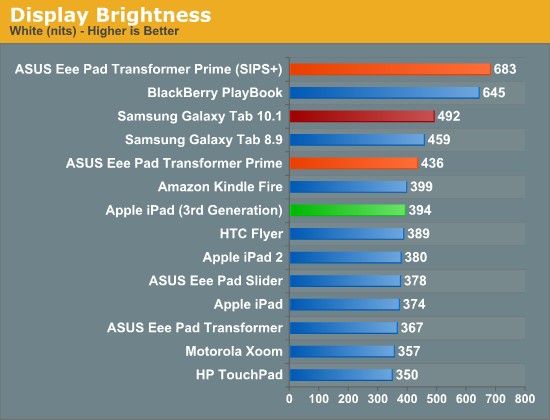
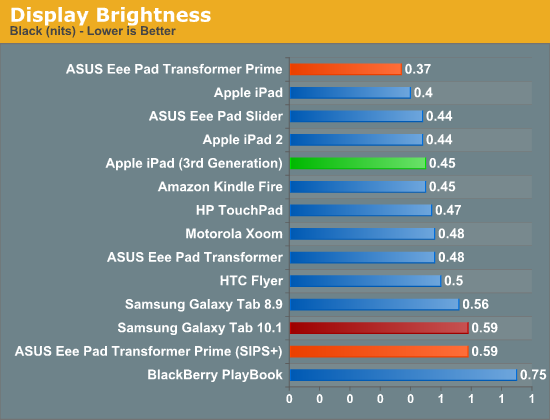
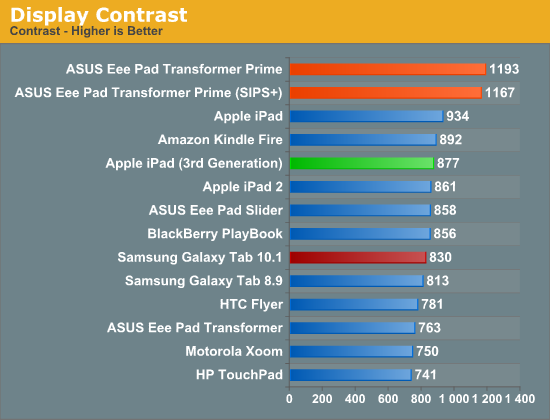
Apple is expected to have triple sourced panels for the new iPad, so you can expect to see variation in these results but for the most part you can expect the new iPad's display to perform similarly to the previous model.
Despite similar brightness and contrast to the previous model, the new iPad offers remarkably better color gamut and color reproduction than its predecessor. Relative to other tablets, the iPad's display is spectacular.
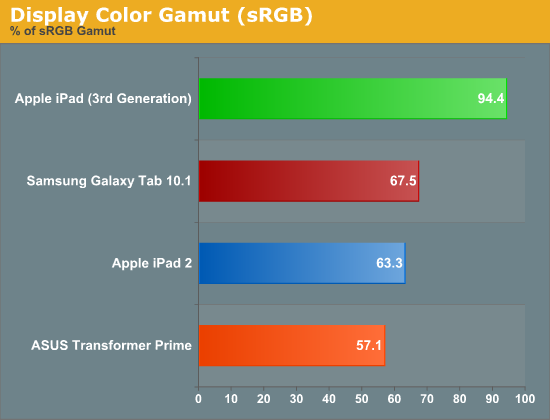
As we mentioned in our Retina Display analysis, Apple delivered on its claims of a 44% increase in color gamut. The new iPad offers nearly full coverage of the sRGB color space and over 60% of the Adobe RGB gamut:
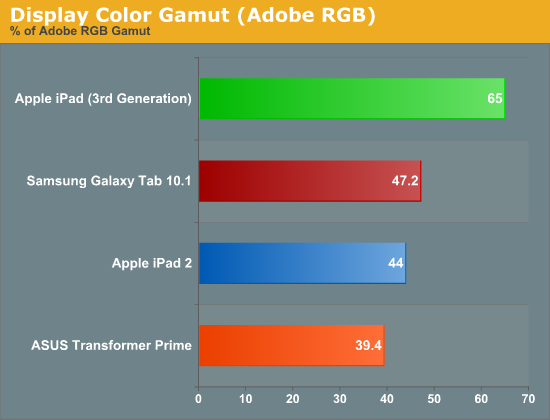
Below is the CIE diagram for the new panel with an sRGB reference plotted on the same chart so you can visualize the data another way:
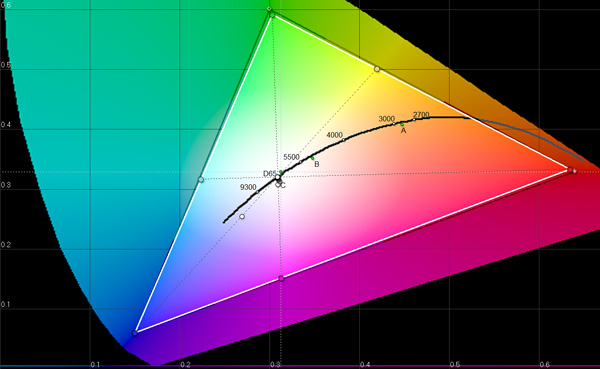
Color accuracy has improved tremendously if we look at delta E values for the primary and secondary colors:
Remember from our display reviews, lower delta E values indicate greater color accuracy. Values below 4 are typically considered good and you can see that the iPad 2 as well as the Transformer Prime both fell short in this department. With the new iPad Apple has clearly focused on color accuracy, which makes sense given it was used as the vehicle to introduce iPhoto for iOS.
Apple still has a lot of work ahead of itself to really put forth a professional quality display in a tablet, but for now the Retina Display is easily the best we've seen in a tablet and a tremendous step forward.
What's most absurd about the iPad's Retina Display is that you're able to get this resolution and panel quality in a $499 device. While we must be careful not to give Apple too much credit here as Samsung, Sharp and its other display partners clearly make the Retina Display, it's obvious that Apple has really been pushing its partners to develop solutions like this.
The biggest problem in the production of any commoditized component is the primary motivation for innovation is to lower cost. For years I argued with notebook PC makers to use higher quality LCD panels but no one was willing to commit to the quantities that would lower costs enough. I was also told that as soon as you put these notebooks on shelves at Best Buy, users wouldn't really care whether they were getting a high quality IPS display or not—all that mattered was the final price.
Apple, under the leadership of Steve Jobs, had a different mentality. Steve's pursuit was quality and experience, cost was a secondary concern. Through slow and steady iteration of this approach, Apple was able to build up a large enough customer base and revenue to be a significant force in the industry when it came to driving costs down. Apple can easily fill your fabs and eat all that you can produce, but you'll have to do whatever it wants to get the order.
Apple's behavior since it got rich has been to drive down the cost of higher quality components, LCDs being a perfect example. Unfortunately other companies don't benefit as much here as Apple tends to buy up all of the production of what it has pushed to create. That's one reason why, although ASUS was first to introduce a 1080p Transformer Pad, it won't launch until well after the new iPad. From what I've heard, the panel makers are all busy servicing Apple's needs—everyone else comes second.
Eventually the entire industry will benefit and all indications point to Apple doing something special for "pro" users in the notebook space next. As I've said previously, Apple has raised the bar with the iPad's Retina Display. The time for average display quality in a $500 tablet is over, the bar has been raised. It remains to be seen whether or not Apple will be able to maintain this quality across all suppliers of its Retina Display. On the iPhone Apple has been entirely too lax about maintaining consistency between suppliers. If it wants to be taken seriously in this space Apple needs to ensure a consistent experience across all of its component vendors.

















234 Comments
View All Comments
ananduser - Thursday, March 29, 2012 - link
Imagination does own the fastest GPU available today. The current Tegra offerings cannot match it but nvidia goes a different way. They will start piling CUDA cores like they do on the desktop GPU front. Say you'll have in the future a better quad core from Imagination and nvidia's GPU will consist of something like 64 CUDA cores.zorxd - Thursday, March 29, 2012 - link
The problem is that you can't plug an iDevice to a computer a transfer files as you would on a USB thumb drive without iTunes. That's a major disadvantage.Also if you excluse Apple's SoC, what company makes better mobile GPU than Nvidia? The Mali 400 MP4 is good too (about on par it seems), but I wouldn't say that Tegra 3 is the bottom of the performance barrel. You seems to forget the major players of Qualcomm and TI.
darkcrayon - Thursday, March 29, 2012 - link
You can however transfer files to any number of apps via WIFI or with cloud solutions without needing iTunes though. I'd call it a "disadvantage" but not a major one.You're right the Tegra 3 isn't, I was speaking more generally considering how the Tegra 2 performed vs. the competition as well. It just seemed out of place to choose a tablet because you "love nVidia GPUs" when nVidia has not necessarily put out a spectacular GPU in any ARM SoC.
merajaan - Wednesday, March 28, 2012 - link
You guys must be commended on this review. You covered all the areas that I wanted to know about and really didn't leave one stone unturned. I applaud the depth and detail and appreciate that you didn't rush your review out for launch day like many other sites. I also appreciate the unbiased nature in which the review was written and your honest viewpoints!Anand Lal Shimpi - Thursday, March 29, 2012 - link
Thank you for the kind words :)Take care,
Anand
repoman27 - Thursday, March 29, 2012 - link
So you've gone and included a lovely example of how the AnandTech icon looks at 72 and 144 dpi... How's about including <link rel="apple-touch-icon" sizes="144x144" href="icon144.png"/> on this site so we can have a proper icon when we add an AnandTech web clip to our home screens?adrien - Thursday, March 29, 2012 - link
Still reading the review (and liking it), I'm wondering about thermals.What was the temperature of the room? Could you try with different room temperatures? (I'm wondering how it'll change when it gets 15°C hotter and how it'll fare with sun shining on it).
Is there CPU or GPU throttling when it starts heating? Do you know the SoC temp?
Thanks. :-)
Anand Lal Shimpi - Thursday, March 29, 2012 - link
The ambient temperature in the room was approximately 23C. An overheating condition will trigger an OS-wide warning, which I believe causes the system to shut down.I unfortunately don't have access to anything that could read the SoC temp.
Testing at different room temperatures is an interesting idea but one that would be difficult to accurately control without some serious equipment. I ran these tests side by side at the same time to avoid issues with a changing ambient temperature.
Take care,
Anand
adrien - Thursday, March 29, 2012 - link
Ok, thanks. With summer approaching (and very quickly in France), I guess we'll see real-world tests for the temperature in a few weeks anyway. ;-)scribby - Thursday, March 29, 2012 - link
Nice review :)I'm also wondering about thermals,
What was the brightness level when measuring the thermals on the new ipad?
Thank you.